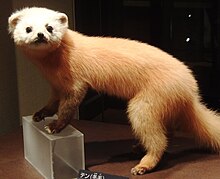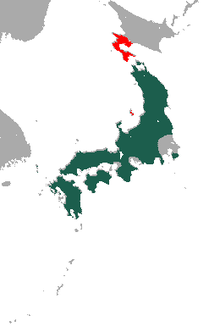Japanese marten
| Japanese marten | |
|---|---|
 | |
| A stuffed specimen exhibited in the National Museum of Nature and Science, Tokyo | |
Conservation status | |
| Scientific classification | |
| Domain: | Eukaryota |
| Kingdom: | Animalia |
| Phylum: | Chordata |
| Class: | Mammalia |
| Order: | Carnivora |
| Family: | Mustelidae |
| Genus: | Martes |
| Species: | M. melampus |
| Binomial name | |
| Martes melampus (Wagner, 1841) | |
 | |
| Japanese marten range | |
| Synonyms | |
| Crocutictis melampus | |
The Japanese marten (Martes melampus) is a marten species endemic to Japan.
Description
It is 0.5 m (1.6 ft) in length typically, not including a 20 cm (8 in) long tail, and between 1 and 1.5 kg (2.2 and 3.3 lb) in weight. Males are generally larger than females. The pelage varies in color from dark brown to dull yellow with a cream-colored throat.[2]
Diet and behavior
Both males and females are territorial; the size of each individual's territory depends on food availability. The Japanese marten is omnivorous, preferring meat from fish, frogs, and small birds and mammals, but consuming insects, fruit, and seeds when necessary.[2]
Taxonomy and distribution
The two confirmed subspecies of Japanese marten are:
- M. m. melampus lives on several of the Japanese islands.
- M. m. tsuensis is endemic to Tsushima Island.[1]
It is most closely related to the sable (M. zibellina), with which it is sympatric on Hokkaido.
The Japanese marten's presence on Hokkaido and Sado islands is due to introductions. It has been recorded in South Korea, but no locality details prove a wild origin and no native population has been confirmed.
Reproduction and lifecycle
The Japanese marten breeds between March and the middle of May. They usually produce one kit (offspring); however, they can have up to five kits per mating season. The offspring are born blind and deaf. As it is a mammal, the female produces milk for her young offspring, but by 3–4 months of age the kits are able to hunt, and they soon leave their mother. They mature sexually between 1 and 2 years old. Average lifespan in the wild is unknown, although a specimen in captivity lived for a little more than 12 years.
After reaching maturity, young martens often try to establish their territory. They mark their territory with scent marking.[2]
Habitat
Japanese martens live in boreal forests in much of Japan's mainland.[clarification needed][Does this mean Honshu, or what?] In the winter, martens tend to go to the forests where they can get the most prey. They tend to choose well-established forests because of the ways the creatures have specialized[clarification needed] and due to their long lifespan. Thus martens may be useful in assessing the health of the forest. However, in the summer, their habitat and diet become much more generalized, allowing them to live in a much more varied environment.[3]
Ecology

One of the biggest roles martens play in the environment is seed dispersal. Many fleshy fruits rely on birds and bats to disperse their seeds; however, in more northern climates, the numbers of these species decrease. With the decrease of these species also comes a decrease in seed dispersal. In these areas, carnivores with omnivorous diets, like the Japanese marten, can become the vector of dispersal. These carnivores prove to be good dispersal mechanisms because they often have large home ranges leading to dispersal farther from the parent. Furthermore, since the carnivores are usually larger than birds or bats, they can carry and disperse larger seeds. Around 62% of the Japanese martens' feces contained one or more seeds.[4]
Effects on humans
Japanese martens have both positive and negative impacts on human activities in their habitats. As a positive, the martens prey on Japanese hares (Lepus brachyurus), which lower the quality of trees by their browsing. However, their prey also can include many insects which aid agriculture.[2]
Threats and conservation efforts
The biggest threat to the Japanese marten is the logging industry, which targets its preferred habitat of well-established forests. The industry often clear cuts forests quickly destroying the creatures habitat without allowing it to recover. This practice also causes insularization of marten populations, in turn causing changes in foraging behaviors and the decrease of the genetic pool.[3] Furthermore, pine plantations in their ecosystems do not contain important food for the martens.[2]
Steps have been taken to try to conserve the martens. The most common are regulations on trapping.[3] The species was named as a Natural Monument Species in Japan in 1971, drawing attention to the species' vulnerability. The species also has been given legal protection on Tsushima Islands.[2]
Legends

In the Iga region, Mie Prefecture, is the saying, "the fox has seven disguises, the tanuki has eight, and the marten has nine," and a legend relates how the marten has greater ability in shapeshifting than the fox (kitsune) or tanuki. In the Akita Prefecture and the Ishikawa Prefecture, if a marten crosses in front of someone, it is said to be an omen for bad luck (the weasel has the same kind of legend), and in the Hiroshima Prefecture, if one kills a marten, one is said to soon encounter a fire. In the Fukushima Prefecture, they are also called heko, fuchikari, komono, and haya, and they are said to be those who have died in avalanches in disguise.[5]
In the collection of yōkai depictions, the Gazu Hyakki Yagyō by Sekien Toriyama, they were depicted under the title "鼬", but this was read not as "itachi" but rather "ten",[6] and "ten" are weasels that have reached several years of age and became yōkai that have acquired supernatural powers.[7] In the depiction, several martens have gathered together above a ladder and created a column of fire, and one fear about them was that if martens that have gathered together in this form appear next to a house, the house would catch on fire.[8]
References
- ^ a b Abramov, A.V.; Kaneko, Y.; Masuda, R. (2015). "Martes melampus". IUCN Red List of Threatened Species. 2015: e.T41650A45213228. doi:10.2305/IUCN.UK.2015-4.RLTS.T41650A45213228.en. Retrieved 25 September 2021.
- ^ a b c d e f "Martes melampus (Japanese marten)". Animal Diversity Web. Retrieved 2016-03-31.
- ^ a b c Buskirk, Steven (September 1992). "Conserving Circumboreal Forests for Martens and Fishers". Conservation Biology. 6 (3): 318–323. Bibcode:1992ConBi...6..318B. doi:10.1046/j.1523-1739.1992.06030318.x.
- ^ Otani, Tatsuya (2002). "Seed dispersal by Japanese marten Martes melampus in the subalpine shrubland of northern Japan". Ecological Research. 17 (1): 29–38. Bibcode:2002EcoR...17...29O. doi:10.1046/j.1440-1703.2002.00460.x. S2CID 3215445.
- ^ 村上健司 編著 『妖怪事典』 毎日新聞社、2000年、230頁。ISBN 978-4-6203-1428-0。
- ^ 高田衛 監修 稲田篤信・田中直日編 『鳥山石燕 画図百鬼夜行』 国書刊行会、1992年、50頁。ISBN 978-4-336-03386-4。
- ^ 少年社・中村友紀夫・武田えり子編 『妖怪の本 異界の闇に蠢く百鬼夜行の伝説』 学習研究社〈New sight mook〉、1999年、123頁。ISBN 978-4-05-602048-9。
- ^ 多田克己 『幻想世界の住人たち IV 日本編』 新紀元社、1990年、249頁。ISBN 978-4-9151-4644-2。
Further reading
- Japanese Marten on Animal Diversity
- Nowak, Ronald M. (2005). Walker's Carnivores of the World. Baltimore: Johns Hopkins Press. ISBN 0-8018-8032-7
- v
- t
- e
- Kingdom: Animalia
- Phylum: Chordata
- Class: Mammalia
- Infraclass: Eutheria
- Superorder: Laurasiatheria
Feliformia ("cat-like" carnivorans) | |||||||||||||||||||||||||||||||||||||||||||||||||||||||||||
|---|---|---|---|---|---|---|---|---|---|---|---|---|---|---|---|---|---|---|---|---|---|---|---|---|---|---|---|---|---|---|---|---|---|---|---|---|---|---|---|---|---|---|---|---|---|---|---|---|---|---|---|---|---|---|---|---|---|---|---|
| |||||||||||||||||||||||||||||||||||||||||||||||||||||||||||
| |||||||||||||||||||||||||||||||
| |||||||||||||||||||||||||||||||||||||||||||||||||||||||||||||
Caniformia ("dog-like" carnivorans) | |||||||||||||||||||||||||||||||||||||||||||||||||||||
|---|---|---|---|---|---|---|---|---|---|---|---|---|---|---|---|---|---|---|---|---|---|---|---|---|---|---|---|---|---|---|---|---|---|---|---|---|---|---|---|---|---|---|---|---|---|---|---|---|---|---|---|---|---|
| |||||||||||||||||||||||||||||||||||||||||||||||||||||
Pinnipedia (seals) | |||||||||||||||||||||||||||||||||||||||||||||||||
|---|---|---|---|---|---|---|---|---|---|---|---|---|---|---|---|---|---|---|---|---|---|---|---|---|---|---|---|---|---|---|---|---|---|---|---|---|---|---|---|---|---|---|---|---|---|---|---|---|---|
| |||||||||||||||||||||||||||||||||||||||||||||||||
| |||||||||||||||||||||||||||||||
| |||||||||||||||||||||||||||||||||||||||||||||||||||||||||||||||











